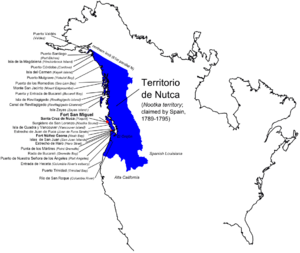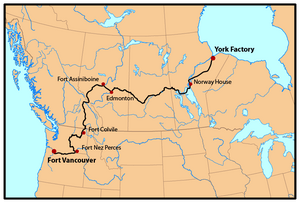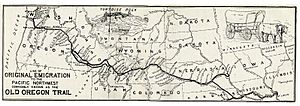Oregon Country facts for kids
Quick facts for kids
Oregon Country
Oregon Country
|
|||||||||||||||||||
|---|---|---|---|---|---|---|---|---|---|---|---|---|---|---|---|---|---|---|---|
| 1818–1846 | |||||||||||||||||||
|
American and Hudson's Bay Company flags were used.
|
|||||||||||||||||||
 |
|||||||||||||||||||
| Capital | Oregon City (US) Fort St. James (British) |
||||||||||||||||||
| Leaders | |||||||||||||||||||
|
• (British; 1818-1822)
|
Governor Joseph Berens of Hudson's Bay Company | ||||||||||||||||||
|
• (British; 1822-1846)
|
Governor John Pelly of Hudson's Bay Company | ||||||||||||||||||
|
• (US; 1841-1843)
|
Supreme Judge Ira Babcock | ||||||||||||||||||
| History | |||||||||||||||||||
|
• Established
|
October 20 1818 | ||||||||||||||||||
|
• North West Company merges with Hudson's Bay Company
|
July, 1821 | ||||||||||||||||||
|
• Fort Vancouver built
|
1824 | ||||||||||||||||||
|
• Oregon City built
|
1829 | ||||||||||||||||||
| February 18, 1841 | |||||||||||||||||||
|
• US Provisional Government
|
May 2, 1843 | ||||||||||||||||||
|
• Organic Laws of Oregon
|
July 5, 1843 | ||||||||||||||||||
|
• George Abernethy becomes Governor
|
June 3, 1845 | ||||||||||||||||||
| June 15, 1846 | |||||||||||||||||||
| Currency | Beaver skin | ||||||||||||||||||
|
|||||||||||||||||||
The Oregon Country was a large area in the Pacific Northwest of North America. In the 1800s, both Great Britain and the United States claimed this land.
Before 1810, British and French Canadian fur traders lived and worked there. American settlers started arriving in the mid-1830s. Ships from many countries, especially from Boston, visited the coast to trade furs.
The Oregon Treaty of 1846 finally settled who owned the land. It drew a border at the 49th parallel. This line separated the British and American parts of the region.
The British called their part the Columbia District. The name "Oregon" was mostly used by Americans. The Oregon Country stretched from 42°N latitude in the south to 54°40′N latitude in the north. It went from the Rocky Mountains in the east to the Pacific Ocean in the west.
Today, this area includes parts of British Columbia in Canada. It also covers the U.S. states of Oregon, Washington, and Idaho. Some parts of Montana and Wyoming were also included. The British presence was mostly managed by the Hudson's Bay Company.
Contents
Exploring the Oregon Country
Many explorers visited the Oregon Country. In 1792, George Vancouver explored Puget Sound for Great Britain. He claimed the area and named it after one of his officers.
A year later, in 1793, Alexander Mackenzie was the first European to cross North America by land. He reached the coast of British Columbia.
From 1805 to 1806, Meriwether Lewis and William Clark explored the area for the United States. This was part of their famous Lewis and Clark Expedition.
David Thompson, working for the British North West Company, explored much of the region starting in 1807. His friend Simon Fraser explored the Fraser River in 1808. Thompson was the first European to travel the entire length of the Columbia River. In 1811, he claimed the land around the Snake River for the United Kingdom.
Where Did the Name "Oregon" Come From?
The name "Oregon" has a few possible origins. One idea is that it comes from the Spanish word "orejón." This word was used in a 1598 book about California, mentioning the Columbia River.
Another idea is that the name comes from the Spanish word "oregano." This is a type of plant that grows in the southern part of the region.
Some people think French Canadian fur traders called the Columbia River "hurricane river" (le fleuve d'ouragan). This was because of the strong winds in the Columbia River Gorge.
A different theory suggests the name came from a mistake on an old French map. A river name might have been misspelled, leading to "Ouaricon," which sounded like "Oregon."
How the Land Claims Changed
At first, Great Britain, France, Russia, and Spain all claimed parts of the Oregon Country. The United States later took over Spain's claim. The exact borders were unclear for many years.
The U.S. based its claim on Robert Gray's discovery of the Columbia River in 1792. They also used the Lewis and Clark Expedition as a reason. Great Britain based its claim on explorations by David Thompson and others.
Spain's claim came from old treaties from the 1490s and explorations in the late 1700s. Russia claimed land north of 51°N latitude in 1821. But other countries challenged this, and Russia later agreed to a border at 54°40′N.
In the 1790s, Spain gave up its exclusive claims to the Pacific Northwest. In 1819, Spain gave all its claims north of the 42nd parallel to the United States. Russia also gave up its claims south of 54°40′ in the 1820s.
In 1818, the United States and Britain agreed to "joint occupancy" of the land west of the Rocky Mountains. This meant both countries could use and settle the area.
In 1843, American settlers created their own government called the Provisional Government of Oregon. They wrote laws to govern themselves. This government continued until 1849, even after the border was settled.
Early Settlements and People

In 1805, the Lewis and Clark Expedition built Fort Clatsop. This was the first temporary American settlement in the area. In 1810, John Jacob Astor started building Fort Astoria. This was the first permanent Euro-American settlement, completed in 1811. It became the city of Astoria, Oregon.
During the War of 1812, the British captured Fort Astoria. It was sold to the North West Company and renamed Fort George.
In 1821, the North West Company joined with the Hudson's Bay Company (HBC). The HBC became very powerful in the region. John McLoughlin became the manager in 1824. He moved the main headquarters to Fort Vancouver (now Vancouver, Washington).
Fort Vancouver became a busy community. Many different people lived there, including Scots, English, French Canadians, Hawaiians, and Native Americans.
American fur traders, called "mountain men," also came to the Rockies. They hunted beaver for their valuable fur. The Hudson's Bay Company tried to make it hard for American traders. They sometimes over-hunted areas to create a "fur desert," so Americans would find nothing.
News about the Oregon Country spread in the eastern United States. Some churches sent missionaries to teach the Native Americans. Jason Lee, a Methodist minister, built a mission school in the Willamette Valley in 1834.
American settlers began arriving in large numbers in the early 1840s. They traveled west on the Oregon Trail. This led to more arguments over who owned the land.
The Hudson's Bay Company had discouraged settlement before. But they changed their mind when more Americans arrived. In 1841, James Sinclair led over 100 settlers from the Red River Colony to HBC farms near Fort Vancouver.
However, this effort was too late. In 1843, about 700 to 1,000 American settlers came to Oregon. This event was called "The Great Migration of 1843." It strongly shifted the balance in favor of the Americans.
The Oregon Treaty
In 1843, settlers in the Willamette Valley formed a provisional government. Many people in the United States wanted to claim all of the Oregon Country.
In the 1844 U.S. Presidential election, Democrats wanted to expand into both Texas and Oregon. President James K. Polk supported the 49th parallel as the border for Oregon.
A popular slogan at the time was "Fifty-Four Forty or Fight!" This referred to the northern border of the region. It meant that Americans wanted all the land up to 54°40′N, or they would fight for it. The British government wanted control of all land north of the Columbia River.
Neither country truly wanted another war. So, they reached a peaceful agreement in the 1846 Oregon Treaty. The treaty divided the territory along the 49th parallel. However, all of Vancouver Island remained under British control. This border is still the boundary between British Columbia and the U.S. states of Washington, Idaho, and Montana today.
Hudson's Bay Company Changes
In 1843, the Hudson's Bay Company (HBC) moved its main office from Fort Vancouver to Fort Victoria on Vancouver Island. This move had been planned for a long time.
The fur trade was declining across North America. But the HBC was making more money from selling salmon and lumber to places like Hawaii. Coal was also found on Vancouver Island, which was important for steamships.
Also, the Columbia Bar at the mouth of the Columbia River was dangerous for ships. The largest ships could not even enter the river. The growing number of American settlers in the Willamette Valley also made the HBC worry about the future of Fort Vancouver. They correctly guessed that the final border would not follow the Columbia River.
Oregon Territory is Formed
In 1848, the U.S. part of the Oregon Country officially became the Oregon Territory. In 1849, Vancouver Island became a British colony. The mainland became the Colony of British Columbia in 1858.
Soon after, the region north of the Columbia River was separated. In 1853, the Congress approved the creation of Washington Territory. President Millard Fillmore approved it on March 2, 1853.
Life in the Oregon Country
Alexander Ross, an early fur trader, described the lower Columbia River area:
The river banks are low, with hills in the distance. There are groups of oak trees, pine groves, and other woods. Between these hills is the Willamette Valley, where many elk and deer live. As you go up the river, the land is beautiful. The first obstacle is about forty miles from the mouth. Here, rocks cross the river, forming a horseshoe shape. The water falls about forty feet over these rocks, creating what are called the Falls.
Peter H. Burnett, who lived in Oregon from 1843 to 1848, wrote about the people there:
The people of Oregon were all honest, because there was nothing to steal. They were all sober, because there was no alcohol to drink. There were no greedy people, because there was no money to save. And they all worked hard, because they had to work or starve.
See also
 In Spanish: Oregon Country para niños
In Spanish: Oregon Country para niños








